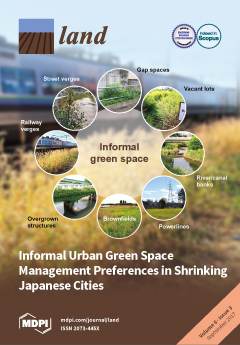Resources
Displaying 1981 - 1985 of 2258Erratum: Viet Nguyen, L., Tateishi, R., Kondoh, A., Sharma, R.C., Thanh Nguyen, H., Trong To, T. and Ho Tong Minh, D. (2016). Mapping Tropical Forest Biomass by Combining ALOS-2, Landsat 8, and Field Plots Data. Land, 5(4), 31.
The authors would like to correct the following errors in Figure 1 in [1]: In the original publication data source is wrong in “Figure 1. [...]
Central Asian ‘Characteristics’ on China’s New Silk Road: The Role of Landscape and the Politics of Infrastructure
China’s $1 trillion One Belt, One Road (OBOR) infrastructure project has significant landscape, socio-economic, and political implications in recipient countries. To date, investigation has focused on Chinese motivation and plans rather than OBOR impact in host nations. This paper examines the programme from the perspective of two Central Asian states—Kazakhstan and Kyrgyzstan—that are at the heart of OBOR.
The Sino-Brazilian Telecoupled Soybean System and Cascading Effects for the Exporting Country
The global food market makes international players intrinsically connected through the flow of commodities, demand, production, and consumption. Local decisions, such as new economic policies or dietary shifts, can foster changes in coupled human–natural systems across long distances. Understanding the causes and effects of these changes is essential for agricultural-export countries, such as Brazil. Since 2000, Brazil has led the expansion of soybean planted area—19 million hectares, or 47.5% of the world’s increase. Soybean is among the major crop commodities traded globally.
The Socio-Ecological Dynamics of Human Responses in a Land Degradation-Affected Region: The Messara Valley (Crete, Greece)
This paper applies a resilience- and assemblage-based methodology to study the socio-ecological dynamics of human responses in the land degradation-affected Messara Valley (Crete, Greece) socio-ecological system, from 1950 to 2010. It posits that thesedynamics aredriven by changes in their effectiveness, called ‘socio-ecological fit’, to serve place- and time-specific goals.
The Integration of Ecosystem Services in Planning: An Evaluation of the Nutrient Retention Model Using InVEST Software
Mapping ecosystem services (ES) increases the awareness of natural capital value, leading to building sustainability into decision-making processes. Recently, many techniques to assess the value of ES delivered by different scenarios of land use/land cover (LULC) are available, thus becoming important practices in mapping to support the land use planning process. The spatial analysis of the biophysical ES distribution allows a better comprehension of the environmental and social implications of planning, especially when ES concerns the management of risk (e.g., erosion, pollution).


